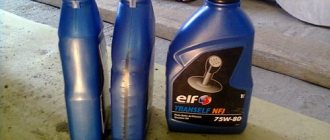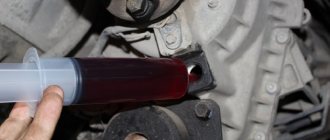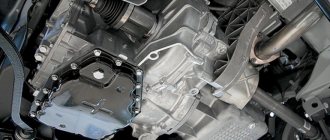According to the Volkswagen Polo owner's manual, replacement lubricant in a manual transmission not provided. It is filled at the manufacturer's factory and serves the entire period of use of the manual transmission. You just need to check its level and, if necessary, top up.
But when using a car for a long time, especially in difficult conditions, the oil heats up, foams and loses its properties . In this case, the gears and parts inside the box will not be sufficiently lubricated, which can lead to the transmission jamming.
Oil change schedule
Oil is poured into it once at the factory and does not change until the unit is completely worn out.
Volkswagen Polo has a maintenance-free manual transmission.
But it’s worth considering: the condition depends on the climate, driving style and other factors. You should also take into account that in Europe a car is rarely in the same hands for more than 7 years, while in Russia this period is much longer.
Although the mechanics of the Volkswagen Polo are durable and reliable, they suffer from:
- bad roads, especially off-road;
- undeveloped service;
- aggressive driving style;
- sharp temperature gradients across seasons;
- careless attitude, etc.
An oil change in a manual transmission is inevitable if:
- noise and knocking that is not typical for her;
- transferring speeds is difficult;
- control and maneuverability of the car have deteriorated;
- the color has changed, an unpleasant odor, foam and impurities have appeared.
Taking into account these factors, and the advice of the experts, it is recommended to change the oil in the manual transmission on the Polo after the next 80,000 km of work. Under severe operating conditions, mileage is reduced to 60 thousand km.
We advise you to read: When to change engine oil
Transmission fluid markings
The properties of lubricating fluids are determined by the API marking. It is international. Russian products are marked with a different letter combination – “TM”. They are identical and have no serious differences.
The marking reflects the performance properties, expressed in the inscription GL and numbers. The higher it is, the more extensive the list of characteristics the product has. The classification is as follows.
| Class | Characteristic | Usage |
| 1 | Virtually no chemical additives | Suitable for gearboxes with low pressure and low rotation speed of parts |
| 2 | Anti-friction additives | Not suitable for high speed units, but compatible with worm gears |
| 3 | Reduce wear of metal parts | Withstands high and medium rotation speeds well |
| 4 | Wide range of additives | Used in most modern cars |
| 5 | Suitable for operating conditions with heavy loads, and therefore minimizes the formation of burrs on the metal | Have a wide range of applications |
| 6 | Maximum number of additives | Adapted for high rotation speeds and used extremely rarely |
Checking the oil level
Oil volume and quality must be checked at least once a year or if there are any leaks. This must be done on a cold unit and in a horizontal position of the vehicle.
- The head unscrews and removes the plug that closes the inspection hole in the manual transmission.
- If the volume is normal, then the oil in the box is at the level of the bottom of the indicator hole.
If the level is insufficient, add oil using the control hole, syringe, or filler hole.
If there is a sudden change in the color of the lubricant, or the appearance of unpleasant odors, foam or impurities, we recommend contacting a specialist.
When should you change?
Many Volkswagen Polo owners have a question about whether it is worth changing the oil in the manual transmission, since the user manual for the vehicle states that the lubricant in the box is designed for the entire service life of the car. Indeed, in a mechanical gearbox, oil is not consumed unless there are structural defects that cause lubricant leakage. However, it should be taken into account that the operational characteristics of machine components and assemblies vary depending on climatic conditions, driving style and many factors that cannot be completely calculated by the manufacturer. In addition, the concept of “operational period” is interpreted differently in our country and abroad. In Germany, the service life of a car rarely exceeds seven years, but in our country a car can be driven for more than thirty years.
A manual transmission, despite high criteria for stability and reliability, in comparison with an automatic transmission, is susceptible to the influence of external factors, poor-quality roads or complete off-road conditions, and significantly depends on the driving style
It is necessary to regularly check the oil level in the Polo Sedan box, and also pay attention to its quality. The indicators for changing the oil in a manual transmission should be the following factors:
- noises and knocks atypical for transmission units;
- difficulties when changing gears or deterioration in the controllability and maneuverability of the machine.
In addition, if, when checking the lubricant level, it is discovered that it has acquired an unnatural shade, has impurities or an unpleasant odor, this indicates the need to replace it. Service center specialists and experienced car owners recommend replacing transmission fluid at least every sixty thousand kilometers. If the car is operated in aggressive conditions, then the working components of the vehicle require more frequent maintenance, approximately every thirty thousand kilometers traveled by the car.
This is interesting: Volkswagen Polo replacing the alternator belt: break it down point by point
What kind of oil to fill in manual transmission
In addition to regularly checking the oil level in the manual transmission, accurate selection is also important, complicated by a wide range.
The manufacturer recommends original oils.
| Name | Articles |
| Cars younger than 12/03/2013 | G 052 512 A2 |
| Cars older than 12/03/2013 | G 052 527 A2 |
For a manual transmission, you need “synthetic” with a viscosity rating according to SAE - 75W-80 and API quality standard - GL 4 and 5. We advise you to buy oil produced by a reliable manufacturer, using only official outlets to avoid buying a fake.
Practical advice on choosing oil for automatic transmission Polo Sedan
Although it is possible to temporarily fill a VW Polo engine with semi-synthetic oil in case of financial problems, such experiments are contraindicated with a Japanese automatic transmission that is quite patient, but at the same time demanding on the quality of oil.
You should not trust suspicious sites and stores that sell original or high-quality similar oil at prices much lower than market prices; this may turn out to be a crude fake and will lead, at best, to the appearance of kicks when driving, and at worst, to complete failure of the automatic transmission.
Read
DIY Nissan Maxima automatic transmission repair
Original oil
Volkswagen recommends for its Polo Sedan to use only original branded automatic transmission oil marked by a German company. The article number of such transmission fluid is G055025A2. 1 liter will cost approximately 1300-1500 rubles.
Analogs
When you don’t want to pay a fairly significant amount for an original Volkswagen transmission fluid, you can try to find atf for automatic transmissions from independent companies. Most often, VW Polo Sedan owners use ATF from Mobil as an analogue, namely Mobil ATF 3309. The cost of 1 liter is approximately 700-800 rubles.
It is also possible to use oil from other reputable companies, such as Toyota, or Aisin, which are also manufacturers of Polo boxes. The main thing is that they have the same clearance.
Changing the oil in a manual transmission for a Polo sedan
Changing the oil in mechanics is carried out in the following order:
- Unscrew the filler plug, having previously cleaned the areas adjacent to the hole with a rag so that no contamination gets into the system.
- Clean the surface around the drain plug and unscrew it, first placing a container for waste. The work is being drained.
- Wait 15 minutes until all the liquid has drained. The drain hole and plug are wiped one more time to remove dirt and metal particles, after which it is screwed in and securely fixed.
- Using the filler hole, a syringe, or using a funnel and flexible hose, oil is poured to the bottom of the indicator perforation. As soon as the lubricant forms a smudge, you need to tighten the plug.
- The engine starts to disperse the oil inside the unit. After which it is turned off, the car is placed on level ground and the fluid horizon is checked again. If the standard is not reached, the lubricant is added and the plug can be tightened.
- A test drive is made to evaluate how the box works while driving. If there are any problems in the form of tight activation, crunching, vibrations, then the problem is not lubrication, and the box needs in-depth diagnostics.
- After finishing the test drive, or after a couple of days of active driving, the car is examined again. If the box is dry and there are no leaks, then the manual transmission oil update is considered completely complete.
The transmission for the Volkswagen Polo sedan is simple and reliable, but in any case it requires regular maintenance and replacement of consumables.
Let's sum it up
Volkswagen Polo manual transmissions are characterized by excellent maintainability, which allows you to service them at home without resorting to the expensive help of professionals. By following simple recommendations, even a novice car enthusiast, without experience in technical work, can successfully change the oil on his own. Monitor the condition of the manual transmission, regularly check the oil level and replace it if necessary, since your safety on the road directly depends on this.
To mix or not
This question worries all car enthusiasts. And there is no single correct answer to it. After all, if you mix transmission oils correctly, you can significantly save your budget.
Otherwise, such actions are fraught with:
- loss of white flakes - only complete flushing of the system will correct the situation; clogging filters; foaming followed by precipitation of different fractions - an oil change in the manual or automatic transmission will be required; squeezing out seals and more.
Typically, mixtures from different manufacturers give this result. Therefore, experienced car owners do not conduct such experiments on vehicles.
A mixture of synthetics and mineral water is also not allowed. These liquids are incompatible and react with each other, which contributes to the rapid failure of the unit.
Mixing oils in a mechanic's box does not immediately produce any pronounced negative consequences. And only after several kilometers the driver notices that the transmission has begun to work worse. In the case of an automatic transmission, the risk is higher - the unit will fail in the first meters. As a result, it will have to be completely changed.
Therefore, it is better not to take risks and avoid mixing. The only exceptions to the rules would be the following situations:
- the unit allows the use of additives to reduce friction - Dexron II can be replaced by III; regardless of the features of the mechanism - Dexron IIE replaces Dexron IID.
Separately, it is worth considering the issue of the need to top up fluid along the way. If the level is reduced and it is impossible to continue further, it is necessary to select a product with the most similar characteristics. But the permissible mileage on such a mixture does not exceed 200 kilometers. Afterwards the system will have to be completely flushed.











